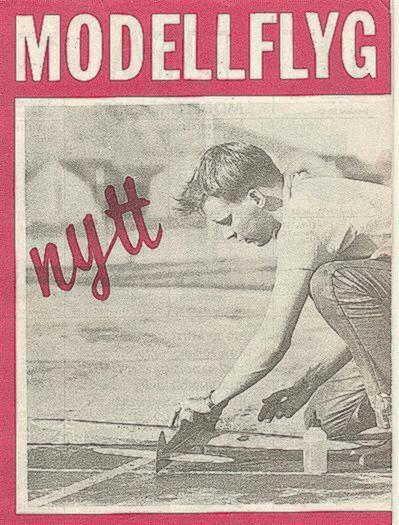
Hail to Myself
or
The Tale of Miss F.A.I.
By Kjell Rosenlund
Translation [with comments] by Göran Olsson, December 1997. [If you find Miss English here, tell me.]

Cover picture shows Kjell in for yet another glorious victory at the Criterium in Genk '61 with Miss F.A.I. IV. [sic. Actually V.]
Maybe it could be of interest to learn what's behind the development of a model that, in spite of everything, became quite successful.
This recapitulation was originally written for another purpose, but has been edited for Modellflygnytt. The somewhat compact presentation remains.
Until now I have built 7 1/2 of them. In addition a large number has been
built by others in Sweden as well as abroad. Requests for pans,
construction hints, and so on have come all the way from New Zealand.
Anyway, here are the data for the originals.
The engine mounted on wooden bearers with dural spacer. Two-wheel landing
gear from 1 mm steel. The wing built from 2 mm balsa sheet with main spar
from pine, 6x8 mm, no trailing edge, leading edge from 1.5 mm hard balsa.
Fuselage with balsa middle sheet, spars and 2 mm sheet covering. Tailplane
3mm HARD balsa. The bellcrank partly countersunk into wing. Leadouts .6 mm
wire inside the wing. Tank of type Edmonds with a ball valve.
Weight 525 grams.
This model was to a large part unflyable. The controls were stuck,
preventing low speed control in start and landing. The tank valve worked
unsatisfactorily, with a varying number of flying laps. The landing gear
was undersized and did not cope with hard landings. Measures taken: The
controls were changed, with the bellcrank fully inside the wing. Tank
replaced by a normal one [three tube]. The landing gear was reinforced
by a piano wire between the wheels. All this helped. The model became
easy to fly and stable. A slight problem of getting the laps, caused by
a pressure difference in the tank tubes, was remedied by soldering a
piece of 2 mm tube inside the face of the overflow tube (3 mm). The tank
was somewhat too wide, and in combination with the engine installation,
caused tendencies to overheat. Attempts to get rid of this with redex
fuel and so on did not help. [Redex was a brand of fuel lubricant
additive.] The ship did on the whole work satisfactorily under its
active life. Then served as spare, spare-spare and was ultimately scrapped.
If the mechanics build the models the builder really gets
to appear in the pictures. Here Kjell is seen as Swedish
Champion with Miss F.A.I. II 1961.
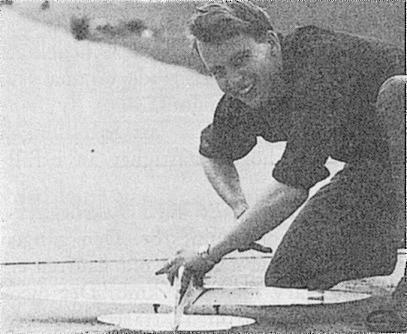 Same design as the above after the modifications, but with a much sturdier
landing gear. Weight 525 grams.
Same design as the above after the modifications, but with a much sturdier
landing gear. Weight 525 grams.
Worked fine from the beginning. No other
problems than cooling, which among other things caused restart problems.
The tank being thinner helped somewhat. Won among other things the Team
Trials '59, Swedish Nats '59 and '60. Finished second at the '59
Criterium, but was disqualified for an oversize tank. Best time 4:48.
The model caught fire on one occasion and later came to a sad end after
1 1/2 years.
Miss F.A.I. III was presented with a plan in Aeromodeller
after the second place at the '60 World Champs.
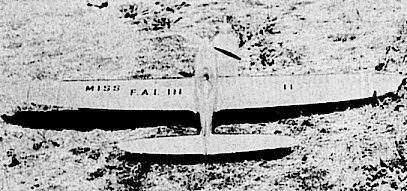 The same construction as the previous, but with a magnesium engine pan.
The plan was published in Aeromodeller, January 1961. [See the Cover.] Weight 525 grams. The tail was extended
10 mm. Very good flying characteristics, no cooling problems. Won Team
Trials '60. Finished first in the '60 World Champs final, but was
disqualified on a non-existing rule and ruled second. Best time 4:39.
Successful, but was alive just one year. Was crushed by a foot at the '61
Team Trials.
The same construction as the previous, but with a magnesium engine pan.
The plan was published in Aeromodeller, January 1961. [See the Cover.] Weight 525 grams. The tail was extended
10 mm. Very good flying characteristics, no cooling problems. Won Team
Trials '60. Finished first in the '60 World Champs final, but was
disqualified on a non-existing rule and ruled second. Best time 4:39.
Successful, but was alive just one year. Was crushed by a foot at the '61
Team Trials.
Miss F.A.I. IV and V (bottom)
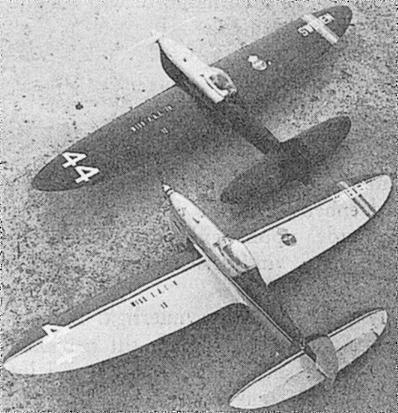 Dimensions as N:o III. The fuselage sheet covering replaced by hollowed
balsa blocks. The wing built from two 5 mm sheet on a frame of 1 mm plywood.
A terribly strong design. A suitcase on the boat to Finland broke the tail,
but this was easily repaired. Magnesium pan, two-leg landing gear, lead outs
from piano wire. Tank: Chicken Hopper. Weight 560 grams.
Dimensions as N:o III. The fuselage sheet covering replaced by hollowed
balsa blocks. The wing built from two 5 mm sheet on a frame of 1 mm plywood.
A terribly strong design. A suitcase on the boat to Finland broke the tail,
but this was easily repaired. Magnesium pan, two-leg landing gear, lead outs
from piano wire. Tank: Chicken Hopper. Weight 560 grams.
Very good flying
characteristics. The tank was difficult to fill and the model was often
released with the tank half-filled. The engine was difficult to set. Change
was made to a normal tank and likewise normal engine (Oliver Tiger). Then
it went fine. The Eta design caused the tank to be more rearward than
normal, which led to tendencies to cut out on acceleration. This was overcome
by moving the tank outward to enable a richer setting. Due to a rule change
to thicker lines, this model had 30 grams of lead in the outer wing tip,
whereas the previous ones had had 25 grams. Won the Nordic (Scandinavian)
Champs '61, Swedish Champs '61, third on Swedish Champs '63. Also won smaller
events. Best time: 4:30.
This ship did fine service over many years, but ultimately got quite worn and showed signs of old age. It was overhauled in 1964 and renamed:
That's Kjell's style: From the World Champs '64.
 The overhaul consisted of:
The overhaul consisted of:
All paint and covering torn off. All worn and oil soaked parts
exchanged. The controls were replaced in part, to remove all play. The
landing gear was changed to a one leg type with a thin plastic wheel.
New pan. New tank of Mariotte type with a prime feed to the exhaust. The
model was covered with tissue (thin, coloured) and was resin finished
without other paint than decoration. The appearance was almost like new.
The weight got down to 535 grams, mainly due to the dismissal of one
landing gear leg and paint reduced to a minimum. The flying characteristics got
better when all play was gone. The tank tube worked fine. The tank gives
an even run the first 15 laps, then chuckling for 7 laps and then again
an even run. This is probably due to capillary forces. In such case a
possible solution would be to change the tube dimensions. The ship still
is alive and flies well. Won Swedish Champs '64 and was second in the
Team Trials '64. Best time: 4:38.
Same design as N:o IV, but with a one leg spring action landing gear.
Originally 30 grams outer tip weight. Weight after modification 590
grams. Flying characteristics: Strange. At take-off the inner wing tip
goes down to touch ground. The take-off was inward, the model fooling
around for 1/2 lap in disregard of the best intentions of the pilot.
Then it stretched the lines and flew well and fast. In other words, unfit
for contest duty. First the tip weight was increased to 44 grams. This
prevented the inner wing tip to go below horizontal. The unruliness at
take-off remained, however. The CG was moved forwards by lead in the
engine room, and everything went to normal. The plastic wheels (2 mm
thickness) last around two contests and then have to be changed. Won a
whole lot, among other things the Criterium '61, Swedish Champs '61,
Nordic Champs '62, fourth in World Champs '64, second in Swedish Champs
'62. Best time: 4:21, at the time an unofficial world record. The model
apparently paid off for its existence, but withdrew a cold autumn day in
Värnamo (stuck lines).
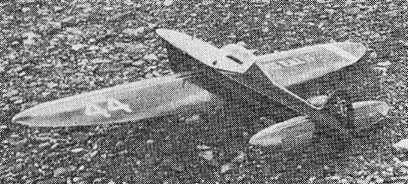 The same design as N:os IV and V. Retracting landing gear. Lead-outs of
piano wire, which often jammed. The hooks were turned the wrong way.
Weight 560 grams.
The same design as N:os IV and V. Retracting landing gear. Lead-outs of
piano wire, which often jammed. The hooks were turned the wrong way.
Weight 560 grams.
The flying characteristics were on the whole good, but some instability
occurred just as the gear was retracted. With the gear out, at low
speed, CG forward, stability was good. Upon retracting the CG moved
backwards without speed being high enough to allow this. Instability
followed during one lap until the speed had increased enough. Right
before the extraction the same thing happened, but lasted longer, as
friction caused the retraction to occur at a higher speed than the
extraction. Aside from that, tests were made with a rear intake and a
tuned intake pipe. The one time the system worked fairly well in the
air, it resulted in 48 laps at 170 km/h. It led to unbelievable
starting difficulties due to large inlet area and overfilling of the
engine. Not suited for practical use unless these obstacles can be
overcome. The model presently rests in the basement.
[This historical artifact, as the first T/R model ever to use a retracting
gear, was kept by former T/R flyer Harald Sannes for a long
time, until it was returned to Kjell on his 50:th birthday.]
An attempt to build a LIGHT model. Wing according to N:o I, but with a main
spar from balsa and leading edge from plywood (1 mm). One leg landing gear
(non-symmetric). The gear 16 mm inside the centre line gives the same
torque as 15 grams of extra lead in the wing tip (span 900 mm). Fuselage from
fiberglass, vertically divided. The balsa surfaces covered with coloured
tissue and resin clad. Weight gain on the model (compared to VI): 50 grams.
Overall weight: 455 grams.
Tank according to IV B. The nose 100 mm shorter
than previous. The speed 5 km/ faster than IV B (same engine ...)
The acceleration was very fast. But alas... too sensitive to wind. Hard to
point land in a storm, and not as much a "stone on a string" as its
predecessors. This might be improved by moving the CG forwards. The landing
gear was attached to a plywood spar epoxied to the glass shell. This joint
came loose at a not too hard landing, and the spar broke. Will be repaired
in time when I get the inclination. So far it has acheived a ninth place at
the World Champs '64, with a best time of 4:49.
In addition to these, a much simplified version, Miss F.A.I. J:r, was
designed. [The plan was published in the second issue ever of the
magazine "Hobby" in 1962.] In the hands of less experienced model
flyers this has also acheived good times and shown good flying
characteristics.
It can be said as a curiosity, that in the Belgian team at the
Criterium '61 there was a Miss F.A.I. entering speed! There are several happy
memories and funny events linked to Miss F.A.I, that sometime might become
subjects of another article. [We're still waiting, Kjell! :-) ]
And at last a flower (dandelion) to Nisse [Nils] Björk [the pilot], who actually has some part in the successes (and setbacks).